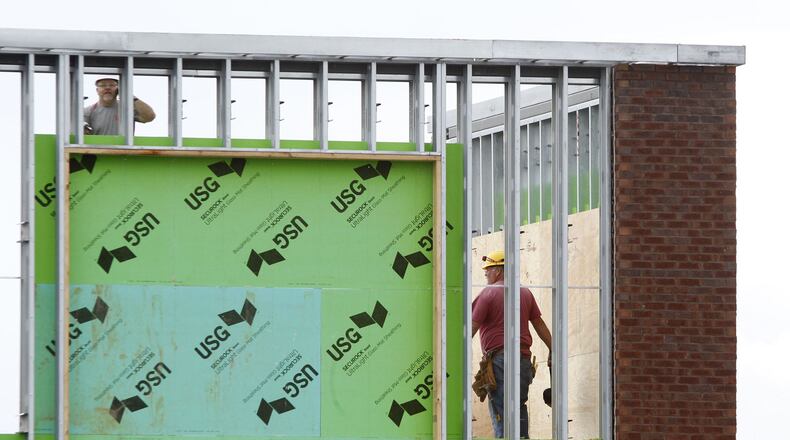The tornadoes happened less than three weeks ago, and no builder who spoke for this story was panicking.
But with a need to rebuild in coming weeks and months, there is an awareness that a longstanding shortage of skilled tradespeople — workers adept in plumbing, electrical work, HVAC installation and repair, pipefitting and other crucial areas — could worsen.
“Now we have this huge massive rebuilding we have to do, and there are only so many contractors in Dayton,” area homebuilder Charlie Simms said. “So I think it makes sense. If there’s a strong potential for a slowdown, it will affect new construction and remodeling.”
“It’s the same battlefront that we’ve been fighting for a long time,” said Eric Farrell, president of the Homebuilders Association of Dayton.
Patrick Williams, operating partner of the COHatch development of the former Myer’s Market space in downtown Springfield, said he has seen no serious delays in any of his projects yet.
“I think every sub(-contractor) in the tri-state area is grabbing this low-hanging fruit, so to speak,” he said.
Workers were briefly diverted from his $1.75 million project in downtown Springfield for tornado-recovery work for about two weeks, Williams said. But that has not seriously affected what has been a six-month job, he said.
“We handled it,” Williams said.
But he sees the potential for challenges down the road.
A strained workforce pipeline, a robust housing market, strong economy and low mortgage rates will all conspire to continue to stretch the industry thin, Farrell believes.
“It’s nothing new to our industry, nothing new to the residential side of things,” he said.
For years, builders have lamented the relative lack of young skilled tradespeople coming up through schools and industry ranks. An August 2017 survey by the Associated General Contractors of America found that 70 percent of construction firms report they have a tough time filling hourly craft positions that represent much of the construction workforce.
“I think the tornadoes on top of the booming economy — there was already a shortage of GCs (general contractors) and electricians and plumbers. That was already an issue before the tornado,” Williams said.
“It’s a fair statement to say that the tragic storms are going to affect availability of skilled tradesmen for 12 to 18 months,” he added. “I mean, there is going to be a challenge.”
Martha Clark said finding a contractor to help with damage to her Trotwood home took some effort. Some contractors told her they aren’t taking jobs in Trotwood, one of the areas hardest hit by the tornadoes.
“They’re saying they just have too many jobs right now,” Clark said. “It is frustrating.”
But adapting to challenges is what builders do, and area homebuilder Simms said he’s not worried yet.
“It’s not keeping me up at night,” Simms said.
The potential for contractors “to be stretched even thinner” is there, he acknowledged. He feels it’s something local builders have their eye on.
Mike Dungan of JM Dungan Custom Homes said he doesn’t anticipate a shortage of sub-contractors — at least, not yet.
“We have a network of subs that we use,” he said. “We don’t go out into the market to try to find new ones. We have a group of people who work for us that we know we can depend on.”
But he added: “The rebuild hasn’t even started. Six months from now, who knows?”
John Morris, president and chief executive of the Ohio Valley Associated Builders and Contractors, said on average nationwide, contractors have more than 10 months of jobs already on the books for their existing workforce.
“The contractors in our region are already stacked up almost a year” with work, Morris said.
The YourFutureCareer.org web site, built in partnership with the Dayton Region Manufacturers Association, has sought to introduce young people into the trades, Morris said. That works need to continue, he says.
But this is more than simply a shortage of apprentices. There is a shortage of executives, a shortage of managers, safety professionals, estimators and more, he said.
“The apprentice becomes a journeyman, becomes a superintendent, becomes an executive,” Morris said. “And we just have a shortage across the board.”
Dona Niswonger, president of the HBA of Dayton, said builders have always scrambled to find workers. Now, a new concern is one that Montgomery County Prosecutor Matthias Heck has recently warned about: Bad actors descending on Dayton looking for building work, pretending to be licensed legitimate contractors.
“Our biggest concern is the fact that we have so many people coming in from across the Untied States wanting to do work,” Niswonger said. “And that’s scary, because you don’t know what you’re getting.”
Tornadoes by the numbers
15: Tornadoes that touched down in Miami Valley
70,000: Households left without power on Day 1
942: Homes and buildings destroyed in 10 Ohio counties
837: Structures that suffered “minor damage.”
About the Author

